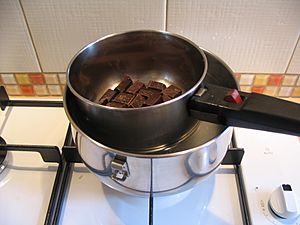Bain-marie facts for kids
A bain-marie (say "ban mah-REE") is a special kitchen tool. It's also used in science and factories. It helps to heat things gently and slowly, or to keep them warm for a long time. Think of it like a warm bath for your food or materials!
Contents
What is a Bain-Marie?
A bain-marie comes in many shapes and sizes. But usually, it's a metal container with a few main parts:
- An outer pot that holds a liquid, usually water.
- An inner, smaller pot that fits inside the outer one. This is where you put the food or material you want to heat.
- Sometimes, there's a base with a heater underneath.
The smaller pot sits about halfway into the water in the outer pot. When you heat the outer pot, the water gets warm. This warm water then gently heats the contents of the inner pot. The water acts like a cushion, stopping the food from burning or boiling too fast.
If you use water in the outer pot, the temperature inside the smaller pot won't go above 100 degrees Celsius (the boiling point of water). But you can use other liquids, like oils or salt solutions, to get different temperatures.
Other Types of Bain-Marie
Today, there are also electric versions of the bain-marie.
- Dry-heat bain-marie: These don't use water. Instead, an electric heater warms the pots directly from below. They often use less energy and heat up faster. They can also get hotter than traditional water baths.
- Wet electric bain-marie: These still use heat from hot water, vapor, or steam. Some have a small tub of hot water, while others use very hot steam to heat the food.
How is it Used in Cooking?
Bains-marie are super useful in the kitchen for many reasons:
- Melting chocolate: It helps chocolate melt smoothly without burning or becoming lumpy. Some special dessert bains-marie are even used for chocolate fondue!
- Baking cheesecake: Cheesecakes are often baked in a bain-marie. This stops the top from cracking in the middle.
- Cooking custard: It helps custards cook evenly. It also stops a hard crust from forming on the outside before the inside is ready.
- Making delicate sauces: Sauces like Hollandaise need gentle heat. A bain-marie stops them from curdling or separating.
- Cooking meat dishes: Some meat dishes, like terrines and pâtés, are cooked in an "oven-type" bain-marie.
- Thickening milk: It's easy to thicken condensed milk for candies using a bain-marie.
- Keeping food warm: They are great for keeping food warm for a long time, especially when a stove or hot plate is too strong.
Where Did the Name Come From?
Bains-marie were first used by alchemists (early scientists who tried to turn metals into gold). They needed a way to heat their materials very slowly and gently. They believed this gentle heating was like how precious metals formed naturally deep inside the Earth.
The name "bain-marie" comes from a Latin phrase, balneum Mariae, which means "Mary's bath." There are a few ideas about which "Mary" it refers to:
- Some say it was named after Maria de'Cleofa. She was from Florence, Italy, and developed the technique in the 1500s.
- Another popular idea is that it was invented by an ancient alchemist named Mary the Jewess. Some even thought she was Moses's sister, Miriam. But historians believe Mary the Jewess lived in Alexandria, Egypt, much later than Moses.
- Finally, some people think the name refers to the Virgin Mary. Her gentle nature is compared to the gentle heating of this cooking method.
Images for kids
See also
 In Spanish: Baño maría para niños
In Spanish: Baño maría para niños




